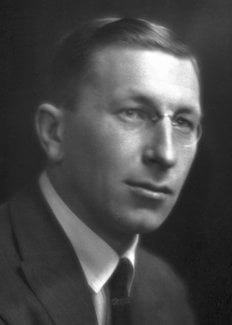Frederick G. Banting
Biographical

Frederick Grant Banting was born on November 14, 1891, at Alliston, Ont., Canada. He was the youngest of five children of William Thompson Banting and Margaret Grant. Educated at the Public and High Schools at Alliston, he later went to the University of Toronto to study divinity, but soon transferred to the study of medicine. In 1916 he took his M.B. degree and at once joined the Canadian Army Medical Corps, and served, during the First World War, in France. In 1918 he was wounded at the battle of Cambrai and in 1919 he was awarded the Military Cross for heroism under fire.
When the war ended in 1919, Banting returned to Canada and was for a short time a medical practitioner at London, Ontario. He studied orthopaedic medicine and was, during the year 1919-1920, Resident Surgeon at the Hospital for Sick Children, Toronto. From 1920 until 1921 he did part-time teaching in orthopaedics at the University of Western Ontario at London, Canada, besides his general practice, and from 1921 until 1922 he was Lecturer in Pharmacology at the University of Toronto. In 1922 he was awarded his M.D. degree, together with a gold medal.
Earlier, however, Banting had become deeply interested in diabetes. The work of Naunyn, Minkowski, Opie, Schafer, and others had indicated that diabetes was caused by lack of a protein hormone secreted by the islets of Langerhans in the pancreas. To this hormone Schafer had given the name insulin, and it was supposed that insulin controls the metabolism of sugar, so that lack of it results in the accumulation of sugar in the blood and the excretion of the excess of sugar in the urine. Attempts to supply the missing insulin by feeding patients with fresh pancreas, or extracts of it, had failed, presumably because the protein insulin in these had been destroyed by the proteolytic enzyme of the pancreas. The problem, therefore, was how to extract insulin from the pancreas before it had been thus destroyed.
While he was considering this problem, Banting read in a medical journal an article by Moses Baron, which pointed out that, when the pancreatic duct was experimentally closed by ligatures, the cells of the pancreas which secrete trypsin degenerate, but that the islets of Langerhans remain intact. This suggested to Banting the idea that ligation of the pancreatic duct would, by destroying the cells which secrete trypsin, avoid the destruction of the insulin, so that, after sufficient time had been allowed for the degeneration of the trypsin-secreting cells, insulin might be extracted from the intact islets of Langerhans.
Determined to investigate this possibility, Banting discussed it with various people, among whom was J.J.R. Macleod, Professor of Physiology at the University of Toronto, and Macleod gave him facilities for experimental work upon it. Dr. Charles Best, then a medical student, was appointed as Banting’s assistant, and together, Banting and Best started the work which was to lead to the discovery of insulin.
In 1922 Banting had been appointed Senior Demonstrator in Medicine at the University of Toronto, and in 1923 he was elected to the Banting and Best Chair of Medical Research, which had been endowed by the Legislature of the Province of Ontario. He was also appointed Honorary Consulting Physician to the Toronto General Hospital, the Hospital for Sick Children, and the Toronto Western Hospital. In the Banting and Best Institute, Banting dealt with the problems of silicosis, cancer, the mechanism of drowning and how to counteract it. During the Second World War he became greatly interested in problems connected with flying (such as blackout).
In addition to his medical degree, Banting also obtained, in 1923, the LL.D. degree (Queens) and the D.Sc. degree (Toronto). Prior to the award of the Nobel Prize in Physiology or Medicine for 1923, which he shared with Macleod, he received the Reeve Prize of the University of Toronto (1922). In 1923, the Canadian Parliament granted him a Life Annuity of $7,500. In 1928 Banting gave the Cameron Lecture in Edinburgh. He was appointed member of numerous medical academies and societies in his country and abroad, including the British and American Physiological Societies, and the American Pharmacological Society. He was knighted in 1934.
As a keen painter, Banting once took part of a painting expedition above the Arctic Circle, sponsored by the Government.
Banting married Marion Robertson in 1924; they had one child, William (b. 1928). This marriage ended in a divorce in 1932, and in 1937 Banting married Henrietta Ball.
When the Second World War broke out, he served as a liaison officer between the British and North American medical services and, while thus engaged, he was, in February 1941, killed in an air disaster in Newfoundland.
Frederick G. Banting died on February 21, 1941.
This autobiography/biography was written at the time of the award and first published in the book series Les Prix Nobel. It was later edited and republished in Nobel Lectures. To cite this document, always state the source as shown above.
The Nobel Foundation's copyright has expired.Nobel Prizes and laureates
Six prizes were awarded for achievements that have conferred the greatest benefit to humankind. The 14 laureates' work and discoveries range from quantum tunnelling to promoting democratic rights.
See them all presented here.
